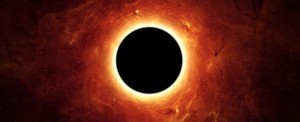New research has expanded on the discovery of a strange phenomenon called blackbody force, showing that the effect of radiation on particles surrounding massive objects can be magnified by the space that warps around them.
The find could affect how we model the formation of stars and planets, and even help us finally detect a theoretical form of radiation that allows black holes to evaporate.
In 2013, physicists announced radiation emitted from objects called ‘blackbodies’ could not only nudge small particles away, but tug them closer. What’s more, for hot-enough objects with only a small amount of mass, the pushing force could be stronger than their gravitational pull.
If you’ve never come across the term, a blackbody is any opaque object that absorbs visible light, but doesn’t reflect or transmit it.
Technically, blackbodies describe theoretically perfect objects that cannot reflect any light at all. Physical examples such as the carbon nanotube materials used to make the crazy-looking Vantablack coatings come pretty close.
It’d be a mistake to think of all blackbodies as, well, black – they do emit radiation as their particles jiggle about, making them a useful way to describe an object’s thermal properties.
Four years ago, a team of Austrian researchers figured out that the radiation emitted by a blackbody should have a rather curious effect on nearby atoms.
To understand this effect, it helps to know that atoms can move and change direction when the photons they absorb cause a shift in their momentum.
Given the right conditions, objects as large as a cell can be nudged around by a beam of light – a phenomenon commonly used in a form of technology called optical tweezers.
Physicists have known for about a century that electromagnetic radiation can change the properties of nearby atoms through the Stark effect, which changes the positions of its electrons to sit in a lower energy state.
This happens to make them more likely to move towards towards the brighter parts of a beam of light.
The Austrian researchers put two and two together, showing how heat radiation could cause light to not only push particles away, but thanks to the Stark shift, they could also be pulled towards the object.
“The interplay between these two forces – a typically attractive gradient force versus repulsive radiation pressure – is routinely considered in quantum optics laboratories, but it was overlooked that this also shows up with thermal light sources,” lead researcher Matthias Sonnleitner from the University of Innsbruck told Phys.org back in 2013.
While force is incredibly weak, they also showed that the radiation’s net pulling power could actually be greater than the tiny amount of gravity produced by minuscule, hot objects, having implications for particles smaller than a dust grain.
“These sub-micron-sized grains play an important role in the formation of planets and stars or in astro-chemistry,” said Sonnleitner.
“Apparently, there are some open questions on how they interact with surrounding hydrogen gas or with each other. Right now, we are exploring how this additional attractive force affects the dynamics of atoms and dust.”
Fast-forward to now, and another team of physicists has taken up where Sonnleitner and his colleagues left off, exploring the effect of both the blackbody’s shape and its effect on the curvature of surrounding spacetime on this optical attraction and repulsion.
In particular, they calculated the warping of space – or topology – around a spherical and a cylindrical blackbody, and measured how the differences might affect the blackbody radiation forces.
They found the curvature of the spherical blackbody and the topology of space surrounding it had a magnifying effect on the attractive force due to both the effect of gravity and the angle at which the radiation struck the particles.
This wasn’t the case for the cylinder, with its flat surface and surrounding space, where the blackbody effect wasn’t magnified.
While the effect wouldn’t be detectable in the laboratory, or even for objects the size of our Sun, for massive blackbody objects like neutron stars or more exotic forms of space-bending physics, this effect could make a significant difference.
“We think that the intensification of the blackbody force due to the ultradense sources can influence in a detectable way the phenomena associated with them, such as the emission of very energetic particles, and the formation of accretion discs around black holes,” lead researcher Celio Muniz from Ceará State University, Brazil, explained to Phys.org.
The team also applied the previous findings on the blackbody force to a concept called a global monopole – a theoretical point similar to an electric charge, which affects the shape of surrounding space without gravity – as well as another theoretical warping of space called a cosmic string.
“This work puts the blackbody force discovered in 2013 in a wider context, which involves strong gravitational sources and exotic objects like cosmic strings as well as the more prosaic ones found in condensed matter,” Muniz said.
Ask me anything
Explore related questions





